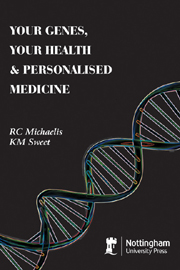Book contents
- Frontmatter
- Contents
- INTRODUCTION
- 1 UNDERSTANDING THE MEANS BY WHICH OUR GENES INFLUENCE OUR HEALTH
- 2 THE MECHANISM WHEREBY A GENE MAKES ITS PROTEIN
- 3 UNDERSTANDING THE PRINCIPLES OF INHERITANCE
- 4 USING YOUR FAMILY HISTORY INFORMATION TO PREDICT YOUR RISK FOR SPECIFIC DISEASES
- 5 USING GENETIC TESTING TO MAINTAIN YOUR HEALTH AND PERSONALISE YOUR MEDICAL CARE, NOW AND IN THE FUTURE
- 6 MAKING THE DECISION WHETHER OR NOT TO HAVE GENETIC TESTING, AND INTERPRETING THE RESULTS OF TESTS YOU CHOOSE TO HAVE PERFORMED
- 7 NUTRIGENOMICS AND EPIGENETICS: THE EFFECTS OUR DIET, ENVIRONMENT AND LIFESTYLE HAVE ON OUR GENES AND PROTEINS
- EPILOGUE AND USEFUL INTERNET RESOURCES
- INDEX
1 - UNDERSTANDING THE MEANS BY WHICH OUR GENES INFLUENCE OUR HEALTH
- Frontmatter
- Contents
- INTRODUCTION
- 1 UNDERSTANDING THE MEANS BY WHICH OUR GENES INFLUENCE OUR HEALTH
- 2 THE MECHANISM WHEREBY A GENE MAKES ITS PROTEIN
- 3 UNDERSTANDING THE PRINCIPLES OF INHERITANCE
- 4 USING YOUR FAMILY HISTORY INFORMATION TO PREDICT YOUR RISK FOR SPECIFIC DISEASES
- 5 USING GENETIC TESTING TO MAINTAIN YOUR HEALTH AND PERSONALISE YOUR MEDICAL CARE, NOW AND IN THE FUTURE
- 6 MAKING THE DECISION WHETHER OR NOT TO HAVE GENETIC TESTING, AND INTERPRETING THE RESULTS OF TESTS YOU CHOOSE TO HAVE PERFORMED
- 7 NUTRIGENOMICS AND EPIGENETICS: THE EFFECTS OUR DIET, ENVIRONMENT AND LIFESTYLE HAVE ON OUR GENES AND PROTEINS
- EPILOGUE AND USEFUL INTERNET RESOURCES
- INDEX
Summary
The Field Of Personalised Medicine Got Off To A Slow Start, But It Has Picked Up Considerable Speed
It All Started With A Mouse
That may sound like the title to a documentary about Walt Disney, but actually, a mouse with an unusual characteristic did begin the process that has led us to the era of personalised medicine. The idea that we are all individuals in the biochemical sense was first formalised in the scientific literature around 1902, when Archibald Garrod (who was later made Sir Archibald Garrod, in recognition of his important work in biochemistry) coined the term “biochemical individuality.” Garrod was doing research using mice as subjects, when he noticed that the bedding in one of his mouse cages turned black after the mice urinated on it.
The black color was due to a substance called homogentisic acid that is not usually present in the urine of mice. There had been a change in the DNA sequence of one of Garrod's mice, which in turn changed the way the mouse's body processed proteins. This resulted in the mouse having homogentisic acid in its urine, which turned black after it sat in the air for a while. One of the most interesting things Garrod observed was that the mice that had this gene mutation did not have any noticeable physical or behavioral abnormalities. Garrod's work demonstrated that there are some individuals in a population whose biochemistry is different from that of the other individuals to have diseases. We now know that this principle applies not only to mice, but to all living creatures, including people.
- Type
- Chapter
- Information
- Your Genes, Your Health and Personalised Medicine , pp. 1 - 24Publisher: Nottingham University PressPrint publication year: 2011



